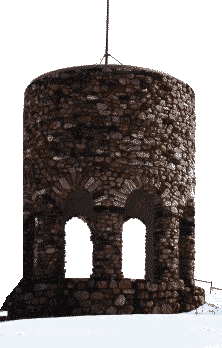
Stafford Hill Monument

Cheshire Massachusetts
| In 1927, the Sons of the American Revolution erected a stone memorial tower in honor of Colonel Joab Stafford, commander of the Silver Greys, the local companies of Berkshire County men who volunteered for the revolutionary cause. |
| Stafford and Captain Samuel Low trained their companies on the level spaces atop Stafford Hill. It was from this hilltop that they marched to Bennington Vermont in August of 1777 to fight in the now famous "Battle of Bennington". The site in Bennington has been preserved with markers and facilities erected to commemerate this battle that wounded Captain Low. After the battle the Silver Greys marched back to Berkshire County victorious, carrying their wounded Captain on a litter. |
| When Colonel Stafford died, he was buried in the old cemetery that was the burial ground for the original settlement, south of where Jenks Road, at one time, crossed the Windsor Road and proceeded south to this cemetery. There are still many graves visible. |
| On Memorial Day in 1927, with impressive military honors, the towns people gathered at this old cemetery and carried the remains of Colonel Joab Stafford to this new memorial tower and reinterred his remains. |
| The tower is a replica of the Newport Tower in Newport Rhode Island that is believed built by Norse explorers dating back to before pilgrim times. It was chosen by the Sons of the Revolution to commemerate Stafford and also the people who settled this hill in the mid 1700's. |
| Stafford Hill was originally purchased in 1766 by Nicholas Cooke of Providence and Joseph Bennet of Coventry Rhode Island. It was settled as New Providence Plantation and was settled mostly by families from Coventry, Providence and surrounding areas of Rhode Island. Stafford was hired to survey the area and divided the original 4,660 acres into 31 lots, eventually settling there on or near this memorial site. |
| Their church was built in about 1774 on the east side of Jenks Road at the north end where the Baptist cemetery still remains. After the congregation had centered more at the top of Stafford Hill, it was voted to build a new meeting house rather than repair the old and it should stand at a new location on top of the hill. It was first voted to build a brick structure but later changed to wooden. |
| Nothing was done and in March of 1817, a new plan was accepted and a committee was empowered to build the church. In October it was voted to take the pine woodwork out of the old meeting house and use it in the new. |
| January 1, 1818 the new church was dedicated. |
| February 19, 1820; it was voted to take down the old meeting house and move and prepare it for the ministers dwelling. |
| The moving of the old church took place in the winter making it easier to move the heavy timbers with sleds. John Wells and John Brown, who were both present, said that the church was moved on a beautiful day and was drawn up the hill by many yoke of oxen and safely deposited. Brown said that his father, who was a blacksmith, furnished the chains. "All the town was there, and a barrel of rum and a good time, and no accidents." was reported by Brown. |
| The church was drawn south on Jenks Road, and then east up the now abandoned old road that eventually becomes the monuments entrance. |
| In 1927 the land where the memorial tower stands was given to the Sons of the Revolution by Edmund and Jesse Jenks's descendants who then owned part of Joab Stafford's home farm. |
| Edmund Jenks came to East Hoosac
(now Adams) Massachusetts and settled on land that he and Jesse Jenks purchased in 1769. Before Jesse came to western Massachusetts, several of his susequent early deeds were signed only by Edmund. Jesse Jenks purchased the land south of his brother Edmund that became Cheshire. The Hoosic Valley High School is situated on part of Jesse's original property. |
| Sometime in Feb. 1790, Jesse Jenks arrived on horseback at the home of his nephew in Adams. He was carrying as much gold and silver as a man could lift, concealed in a bag of oats. He settled opposite the glebe farm (First Baptist Church) on what is now called Stafford's Hill. |
|
Jesse and Edmund's descendants
thrived on Stafford Hill and in Adams, clearing much of the farm
land that is still open pasture and one of the most beautiful
areas in Berkshire County. The site that he settled is marked by
foundations and a large willow that feeds from the water of the
farms well. North and west of the farm site is the family graveyard that is still marked with many stones and was used until the 1850's when some of the graves were removed to the towns main cemetery on West Mountain Road where a virtual Jenks history can be viewed by simply walking through this large, to our rural standards, cemetery. |